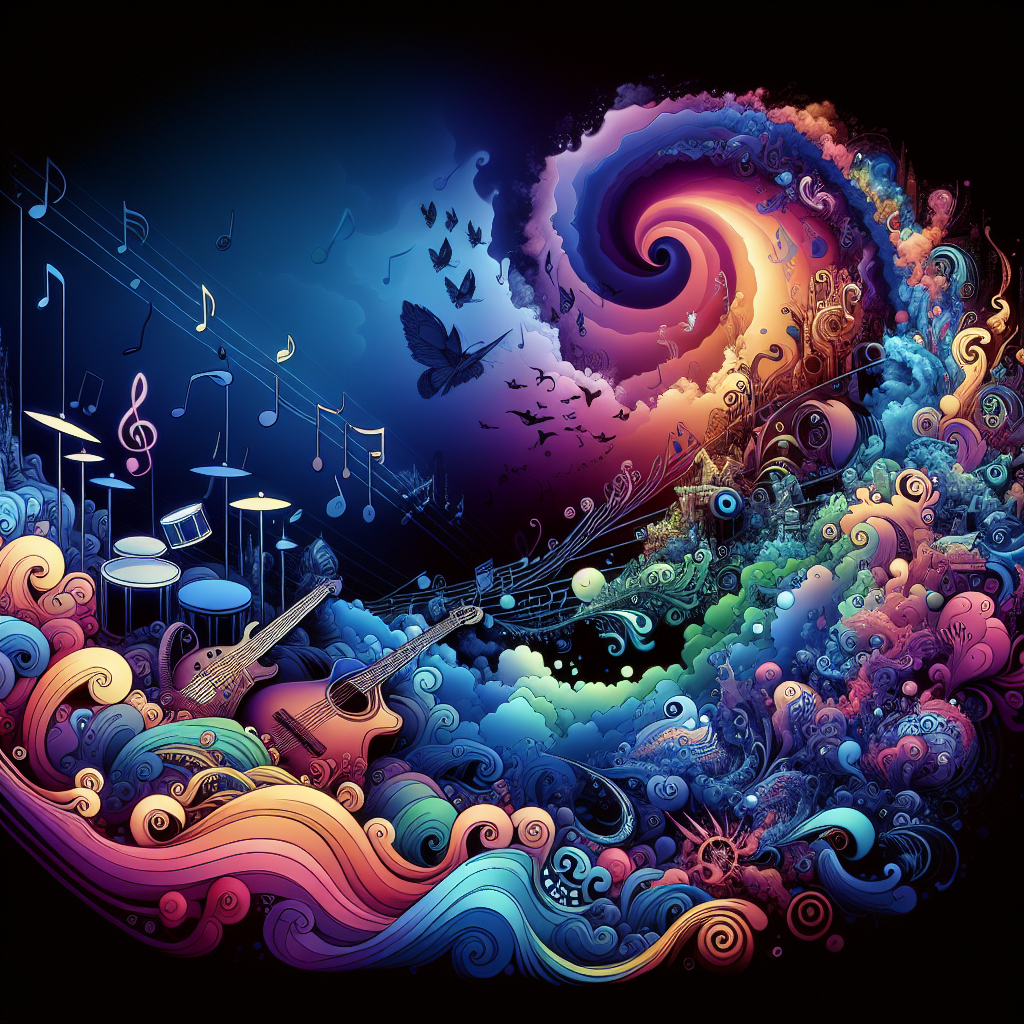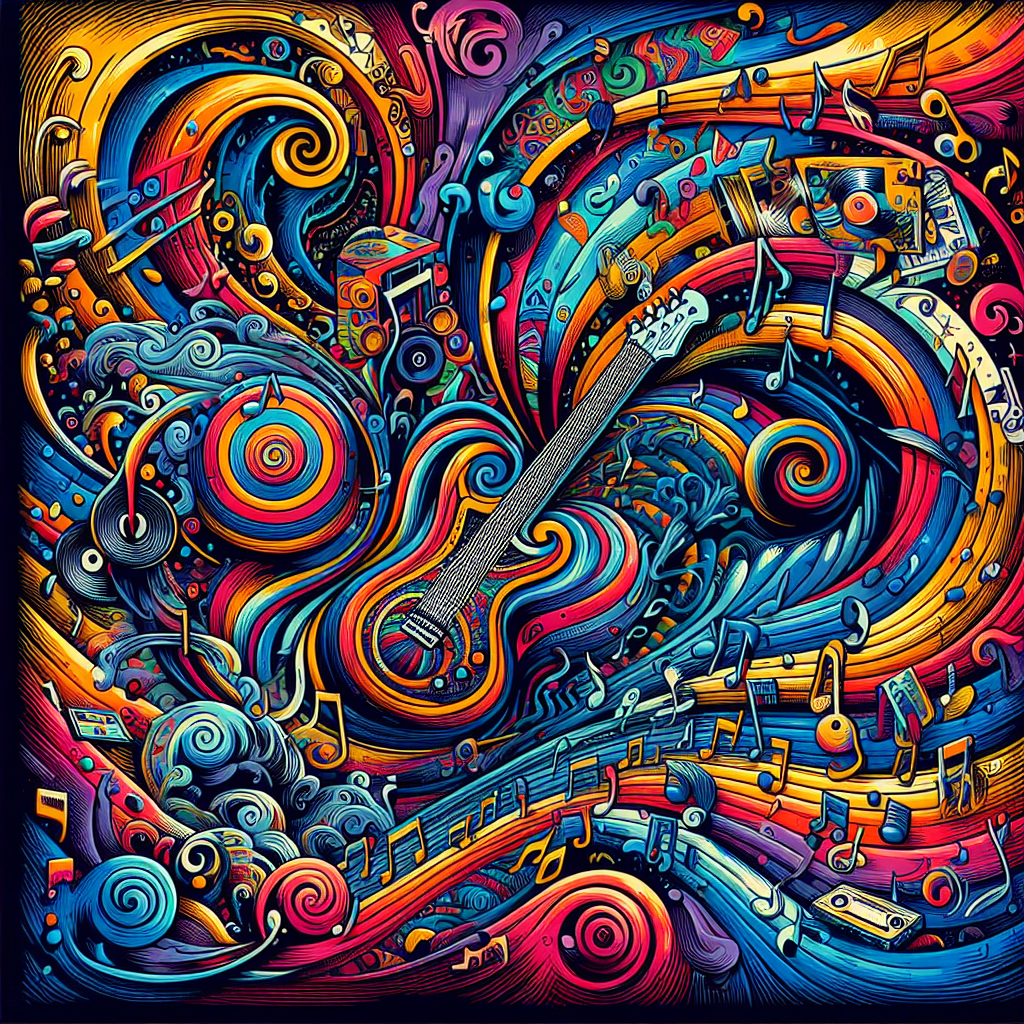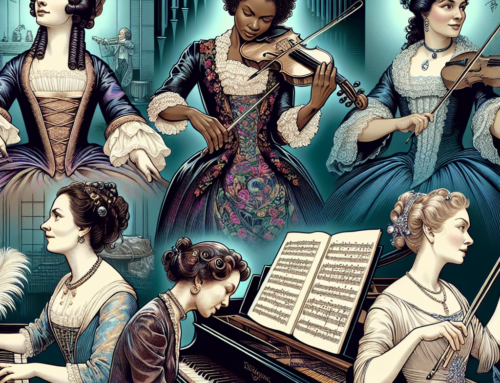“Exploring Echoes of Revolution: The Psychedelic Music Movement’s Enduring Impact on Rock and Pop”
Introduction
The Psychedelic Music Movement, emerging in the mid-1960s, profoundly altered the landscape of rock and pop music, infusing it with experimental sounds, new recording techniques, and lyrical content that explored altered states of consciousness and broader existential questions. Originating in the countercultural fringes, this movement saw artists pushing the boundaries of traditional music to create soundscapes that were both sonically rich and visually vibrant. As psychedelic music gained mainstream popularity, it not only influenced a wide array of genres but also left an indelible mark on the cultural fabric of the era, challenging societal norms and inspiring a generation to explore the depths of perception and the human experience.
The Origins and Evolution of Psychedelic Music in the 1960s
The Psychedelic Music Movement: How It Changed Rock and Pop Forever
The 1960s were a time of profound cultural and musical transformation, marked by a spirit of experimentation and a quest for deeper meaning. At the heart of this revolution was the psychedelic music movement, a genre that not only pushed the boundaries of what music could be but also left an indelible mark on rock and pop music forever. The origins of psychedelic music are as colorful and varied as the sounds it produced, tracing a path through the evolving consciousness of a generation eager to explore the limits of human perception and artistic expression.
Psychedelic music’s roots can be traced back to the early 1960s, with its initial influences stemming from the modal jazz, folk, and classical music scenes. Artists like John Coltrane and Ravi Shankar, with their explorative and transcendental sounds, played a significant role in shaping the early psychedelic soundscapes. However, it was not until the mid-1960s that psychedelic music began to coalesce into a distinct genre, spurred on by the burgeoning counterculture movement and an increasing interest in Eastern spirituality and psychedelic drugs.
The genre officially burst onto the scene with groundbreaking tracks like The Byrds’ “Eight Miles High” and The Yardbirds’ “Shapes of Things,” which incorporated new guitar effects and unconventional song structures that challenged the status quo of pop music. These pioneering tracks laid the groundwork for what was to come, setting the stage for a musical revolution. As the movement gained momentum, bands like The Beatles and The Beach Boys began to experiment with new studio techniques and non-Western instruments, further expanding the sonic possibilities of pop music. The Beatles’ album “Sgt. Pepper’s Lonely Hearts Club Band” and The Beach Boys’ “Pet Sounds” were monumental in this regard, each a masterpiece that showcased the innovative potential of psychedelic music.
Moreover, the movement wasn’t just confined to the United States and the UK. Across the globe, bands took the psychedelic template and infused it with their local sounds and sensibilities, creating a rich tapestry of music that was as diverse as it was revolutionary. In Brazil, artists like Os Mutantes drew upon the psychedelic sound to fuel the Tropicália movement, while in India, musicians like Ananda Shankar merged classical Indian music with psychedelic rock to stunning effect.
As the 1960s progressed, the influence of psychedelic music began to permeate deeper into the rock and pop genres, pushing artists to experiment with lyrical themes of peace, love, and spiritual awakening. This era of musical exploration reached its zenith at the iconic Woodstock festival in 1969, where the ideals of the psychedelic movement were celebrated in a three-day concert that remains one of the most important events in music history.
The legacy of psychedelic music is profound, having reshaped the landscape of rock and pop in ways that are still felt today. It challenged artists to experiment and innovate, setting the stage for future genres like progressive rock, punk, and alternative. The movement also left a lasting impact on the visual arts, fashion, and literature, influencing everything from album covers to clothing styles.
In conclusion, the psychedelic music movement of the 1960s was not just a fleeting period of musical experimentation. It was a profound cultural phenomenon that challenged societal norms, encouraged artistic risk-taking, and redefined what popular music could achieve. Its echoes are still heard in the music of today, a testament to its enduring influence and revolutionary spirit.
Key Figures and Albums in the Psychedelic Music Movement

The Psychedelic Music Movement: How It Changed Rock and Pop Forever
The psychedelic music movement of the 1960s and 1970s stands as one of the most influential periods in the history of music, weaving its colorful threads through the fabric of rock and pop, and leaving a legacy that continues to inspire musicians and fans alike. This era was marked by an explosion of sound, style, and substance that pushed the boundaries of what music could represent and how it could affect the listener.
At the heart of this transformative movement were key figures whose innovative approaches to music and life have become legendary. Among them, The Beatles, particularly with their groundbreaking album “Sgt. Pepper’s Lonely Hearts Club Band,” played a pivotal role in popularizing psychedelic music. Released in 1967, this album was a radical departure from their earlier work, featuring complex arrangements, experimental recording techniques, and lyrics that explored themes of love, consciousness, and the human experience. The album’s lush, layered textures and imaginative cover art set a new standard for what pop music could achieve, both as an art form and as a cultural statement.
Following closely in their footsteps, Pink Floyd emerged as another monumental force within the psychedelic scene. Their 1967 debut album, “The Piper at the Gates of Dawn,” led by the enigmatic Syd Barrett, delved deep into whimsical and abstract soundscapes that captured the essence of psychedelic experimentation. Tracks like “Interstellar Overdrive” showcased extended instrumental passages that seemed to transport listeners to other dimensions, blending rock with elements of jazz and avant-garde.
Across the Atlantic, Jimi Hendrix added his own unique flair to the psychedelic movement. With his virtuosic guitar skills and experimental sound effects, Hendrix pushed the boundaries of electric guitar, turning it into an instrument of sonic exploration. His 1967 album “Are You Experienced” is a landmark in rock history, featuring classics like “Purple Haze” and “The Wind Cries Mary,” which fuse blues, rock, and a psychedelic sensibility into a powerful musical statement about personal and cultural liberation.
Not to be overlooked, The Doors also made significant contributions with their self-titled debut album in 1967. Led by the charismatic Jim Morrison, their music incorporated elements of rock, blues, and jazz, and was steeped in poetic lyrics that explored altered states of consciousness and higher realms of perception. Songs like “Light My Fire” and “The End” are enduring examples of the Doors’ ability to blend moody melodies with introspective lyrics, creating a hypnotic experience that defined the psychedelic sound.
As these artists and albums illustrate, the psychedelic music movement was not just about altered states of consciousness—it was about pushing the limits of musical expression and addressing the social, cultural, and philosophical issues of the time. This era of music challenged listeners to think differently about the world around them, to question the status quo, and to explore new realms of possibility.
Today, the influence of psychedelic music can still be felt across various genres, from rock to electronic to indie pop. Its legacy lives on, not only in the sounds that continue to evolve from its roots but also in the spirit of innovation and exploration that it championed. As we look back on this colorful period, we are reminded of the power of music to change the world, one song at a time.
The Lasting Impact of Psychedelic Music on Modern Rock and Pop Genres
The Psychedelic Music Movement: How It Changed Rock and Pop Forever
The psychedelic music movement of the 1960s was not just a fleeting phase in the history of music; it was a profound revolution that reshaped the sonic landscape of rock and pop for generations to come. This era, marked by an explosion of sound, color, and creativity, left an indelible mark on the music industry, influencing artists and bands to push the boundaries of what music could be.
At the heart of psychedelic music was an ethos of experimentation. Bands like The Beatles, Pink Floyd, and The Jimi Hendrix Experience began to incorporate unconventional instruments, innovative studio effects, and complex compositions that challenged the conventional norms of the rock and pop genres. The use of sitar by George Harrison of The Beatles in tracks like “Norwegian Wood” and the groundbreaking use of the synthesizer by Pink Floyd are prime examples of how psychedelic music started to morph the foundations of rock and pop music.
Moreover, the thematic content of psychedelic music often ventured into more abstract and surreal territories, exploring topics such as existentialism, peace, and love from a deeper perspective. This was not only reflective in the lyrics but also in the album art and live performances, which often included elaborate, colorful light shows and theatrical elements that added to the overall experience of the music. This emphasis on creating an immersive experience influenced countless artists and bands in the decades that followed, encouraging them to consider their music as part of a larger artistic expression.
Transitioning into the 1970s and beyond, the influence of psychedelic music became evident in the emergence of progressive rock and glam rock. Bands like Yes and Genesis took the complex structures and musical virtuosity of psychedelic music and pushed them even further, while artists like David Bowie brought the theatrical and visual elements to new heights. The legacy of psychedelic music also paved the way for the development of electronic music and ambient music, genres that owe much to the experimental spirit of the 1960s.
In contemporary music, the echoes of psychedelic music are still heard loud and clear. Modern bands and artists across various genres—from Tame Impala in rock to The Flaming Lips in alternative music—continue to draw inspiration from the psychedelic era. The use of distortion effects, extended instrumental solos, and a general penchant for exploring the unknown are all hallmarks of psychedelic music that have permeated these modern interpretations.
Furthermore, the resurgence of vinyl records and analog recording techniques in recent years is a testament to the lasting appeal of the warm, immersive soundscapes that were a staple of psychedelic music. This revival not only speaks to a nostalgia for the sounds of the past but also a recognition of the richness and depth that analog technology brought to the music of the psychedelic era.
In conclusion, the psychedelic music movement was much more than just a chapter in the history of music; it was a paradigm shift that introduced a new lexicon of musical expression and creativity. Its impact is not confined to a single era but continues to inspire and influence the music industry, proving that the spirit of the 1960s still resonates with artists and audiences alike. As we look to the future, it is clear that the innovative and exploratory nature of psychedelic music will continue to influence and shape the evolution of rock and pop music in ways we can still only imagine.




